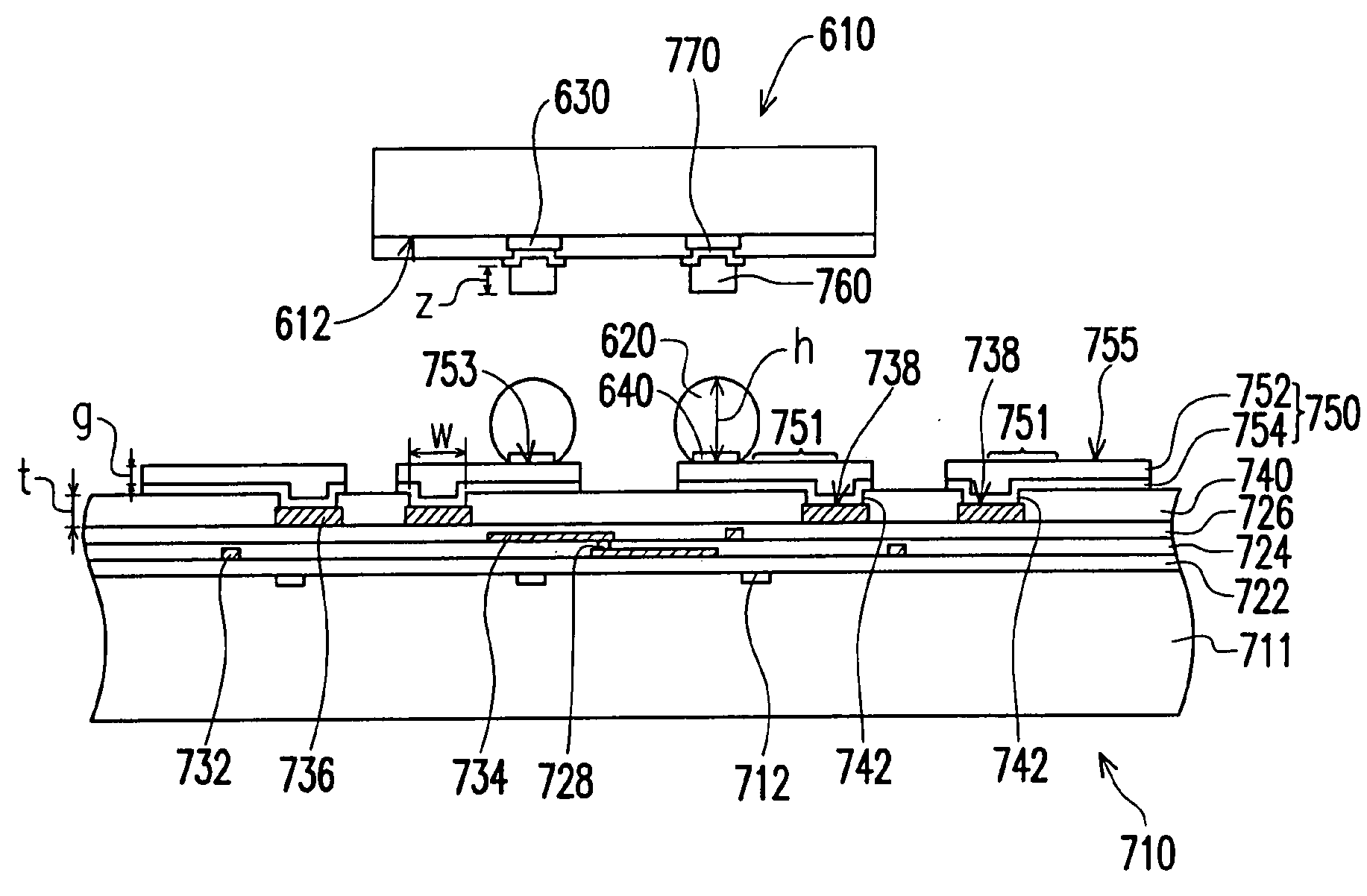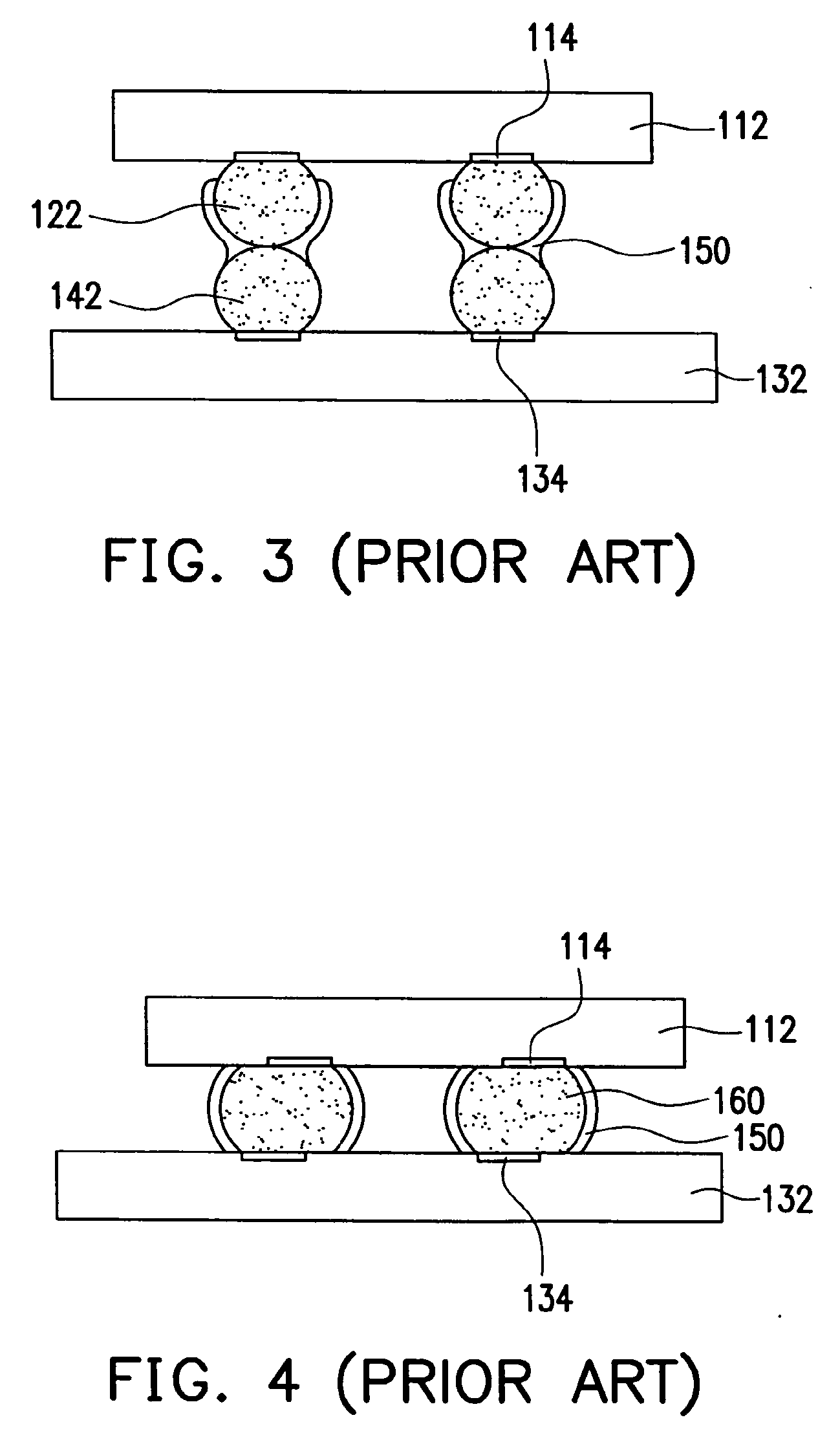Method of assembling chips
a chip and chip technology, applied in the field of chip assembly, can solve the problems of reducing the yield of the package, difficult fabrication process, etc., and achieve the effect of improving the reliability of assembly
- Summary
- Abstract
- Description
- Claims
- Application Information
AI Technical Summary
Benefits of technology
Problems solved by technology
Method used
Image
Examples
first embodiment
[0041]Referring to FIGS. 6 and 7, a cross sectional schematic view of a method for assembling carriers according to the present invention is shown. As shown in FIG. 6, two carriers 210, 220, that is, the first and second carriers 210 and 220 are provided. The first carrier 210 has multiple terminals 212 exposed at a surface thereof. The second carrier 220 has multiple terminals 222 exposed at a surface thereof. The first and second carrier 210 and 220 each includes a chip, a substrate or a ceramic substrate.
[0042]Multiple conductive pillars 230 are formed on the terminals 212 of the first carrier 210, while a conductive connecting material 240 is formed on each of the terminals 222 of the second carrier 220. The material of the conductive pillars 230 is selected from tin, lead, copper, gold, silver, zinc, bismuth, magnesium, antimony, indium and an alloy thereof. The conductive connecting material 240 is in a paste form and can be formed by mixing metal particles and a flux. The con...
sixth embodiment
[0050]Referring to FIGS. 13 and 14, the method of assembling carriers in the present invention is illustrated. Those denoted by the same reference numerals in FIG. 1 indicate the same devices or members and are not described again. After providing the first and second carriers 210 and 220, conductive pillars 230 are formed on each terminal 212 of the first carrier 210. The material of the conductive pillar 230 includes tin, lead, copper, gold, silver, zinc, bismuth, magnesium, antimony, indium or an alloy of the above materials. Conductive pillars 262 and a conductive connecting material 264 are further formed on each terminal 222 of the second carrier 220. The conductive pillars 262 are located on each terminal 222, while the conductive connecting material 264 is formed on the conductive pillars 262 and has a bottom surface 266 in contact with the conductive pillars 262. The materials of the conductive pillars 262 and the conductive connecting material 264 includes tin, lead, coppe...
fourth embodiment
[0072]In the above embodiments, the conductive pillar and the conductive connecting material are used to electrically connect the first chip and the carrier. However, the present invention is not limited to such electric connection. Other method such as wire bonding can also be used for electrically connecting the first chip and the carrier as shown in FIGS. 37 to 42, which illustrate the cross sectional view of the multi-chip package module fabrication in the present invention.
[0073]In FIG. 37, a first chip 410 and a second chip 420 are provided. The first chip 410 has an active surface 414 and a rear surface 416 opposing to the active surface 414. The first chip 410 has a plurality of terminals 412 formed on the active surface 414. A plurality of conductive pillars 430 is formed on the terminals 412 of the active surface 414 of the first chip 410. A conductive connecting material 432 is formed on the conductive pillars 430. The method for forming the conductive pillars 430 and the...
PUM
 Login to View More
Login to View More Abstract
Description
Claims
Application Information
 Login to View More
Login to View More - R&D
- Intellectual Property
- Life Sciences
- Materials
- Tech Scout
- Unparalleled Data Quality
- Higher Quality Content
- 60% Fewer Hallucinations
Browse by: Latest US Patents, China's latest patents, Technical Efficacy Thesaurus, Application Domain, Technology Topic, Popular Technical Reports.
© 2025 PatSnap. All rights reserved.Legal|Privacy policy|Modern Slavery Act Transparency Statement|Sitemap|About US| Contact US: help@patsnap.com



